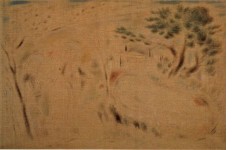TITΛΟΣ ΕΡΓΟΥΟΡΦΕΑΣ ΚΑΙ ΕΥΡΥΔΙΚΗ
ΔΙΑΣΤΑΣΕΙΣ ΕΡΓΟΥΎψος : 100
Πλάτος : 150
ΥΛΙΚΟ ΚΑΤΑΣΚΕΥΗΣΕλαιογραφία (Λάδι σε καμβά)
ΥΠΟΓΡΑΦΗ ΚΑΛΛΙΤΕΧΝΗΔεν είναι υπογεγραμμένο
ΧΡΟΝΟΛΟΓΗΣΗ
ΕΛΕΓΧΟΣ ΓΝΗΣΙΟΤΗΤΑΣΔεν έχει ελεγχθεί

Provenance:
Private collection, Athens.
Frugal in formal vocabulary yet rich in expressive content, this remarkable mythological composition is set in an imaginary arcadia inhabited by idealised figures and abbreviated shapes translated into evocative symbols. Fine lines and curvilinear motifs, sensitive, diluted colours and translucent forms create a magical dreamscape of pure poetry, a barely defined vision that can dissolve and disappear at any moment. 1
This kind of visual poetry charged with spiritual import is achieved by purely pictorial means, showcasing the artist's startling personal amalgam of multiple sources ranging from ancient Greek and Byzantine painting to Far Eastern calligraphy and modern art. "Since his mature period, Parthenis used to paint on the reverse (brown) side of the canvas with discreet, thinned colours, concealing the artist's brush/hand. The objective of such an innovative technique was to capture the spiritual immaterialisation of Byzantine acheiropoiitos icons - holy paintings thought to have been created without the intervention of human hand- and translate it in his unique personal language." 2 Moreover, "the ellipticalness and abbreviation that characterise Parthenis's drawing are expressed in terms of a segmented line that obeys a geometric stylisation of form. This technique derives from Far Eastern, especially Chinese, calligraphy, where voids resulting from segmented outlines acquire a symbolic meaning." 3 Lastly, in the large areas of raw canvas, perhaps the painting's boldest and most captivating feature, Parthenis demonstrates his thorough understanding of modern art's insistence on surface and two-dimensionality. "In some cases I let the canvas retain its natural tint, which perfectly matches the adjacent hues to achieve the result I'm looking for. The canvas is an integral element of a painter's art." 4
The work opens with winged Orpheus playing his lyre, while his beloved wife Eurydice, barely defined in the middle of the picture, reclines diagonally from left to right. The two figures seem enraptured by the divine melody, while the trees framing the composition look as if they are dancing, following the sound of music and irresistibly submitting to the hero's quasi-magical powers. Their melodious curvilinear forms, echoing the graceful lines of the two lovers, are juxtaposed by the vertical motifs of the ancient temple and the slender cypresses5, accentuating rather than downplaying the picture's overall feel of spiritual and moral uplift.
One of the most familiar figures in Greek mythology, Orpheus inherited from his mother, the Muse Calliope, her love of poetry and song. His lyre was a gift from the god Apollo, and he was taught the art of playing by the Muses themselves. From the day he married Eurydice, Orpheus's art soared to new heights and their true, if ill-fated, love blossomed in magnificent melodies. "Sometimes they wandered far a field, enjoying each other's company without a care in the world. They would often sit on a lonely hillside, and as they gazed on the lovely scenery spread below them, Orpheus would take up his lyre while Eurydice sang softly of their great and endless love." 6
1. See S. Lydakis, 'The Stylistic Evolution of Constantinos Parthenis' [in Greek], Zygos magazine, no. 50, November-December 1981, p. 21.
2. D. Paleocrassas, Parthenis, exhibition catalogue, Federation of Greek Industries, Athens 2004, p.11.
3. A. Kafetsi, Parthenis Drawings at the National Gallery [in Greek], Athens 1989, p.153.
4. Interview by N. Yokarinis [in Greek], Proia daily, 27.1.1930.
5. "The vertical is a quintessentially idealistic line symbolising faith and uplift towards the heavens. That's why Parthenis so often makes use of his beloved cypress." Z. Papantoniou, 'The Art of Parthenis' [in Greek], Patris daily, 19.1.1920.
6. Greek Mythology - Gods and Men, Sigma publ., Athens 2000, p. 140.